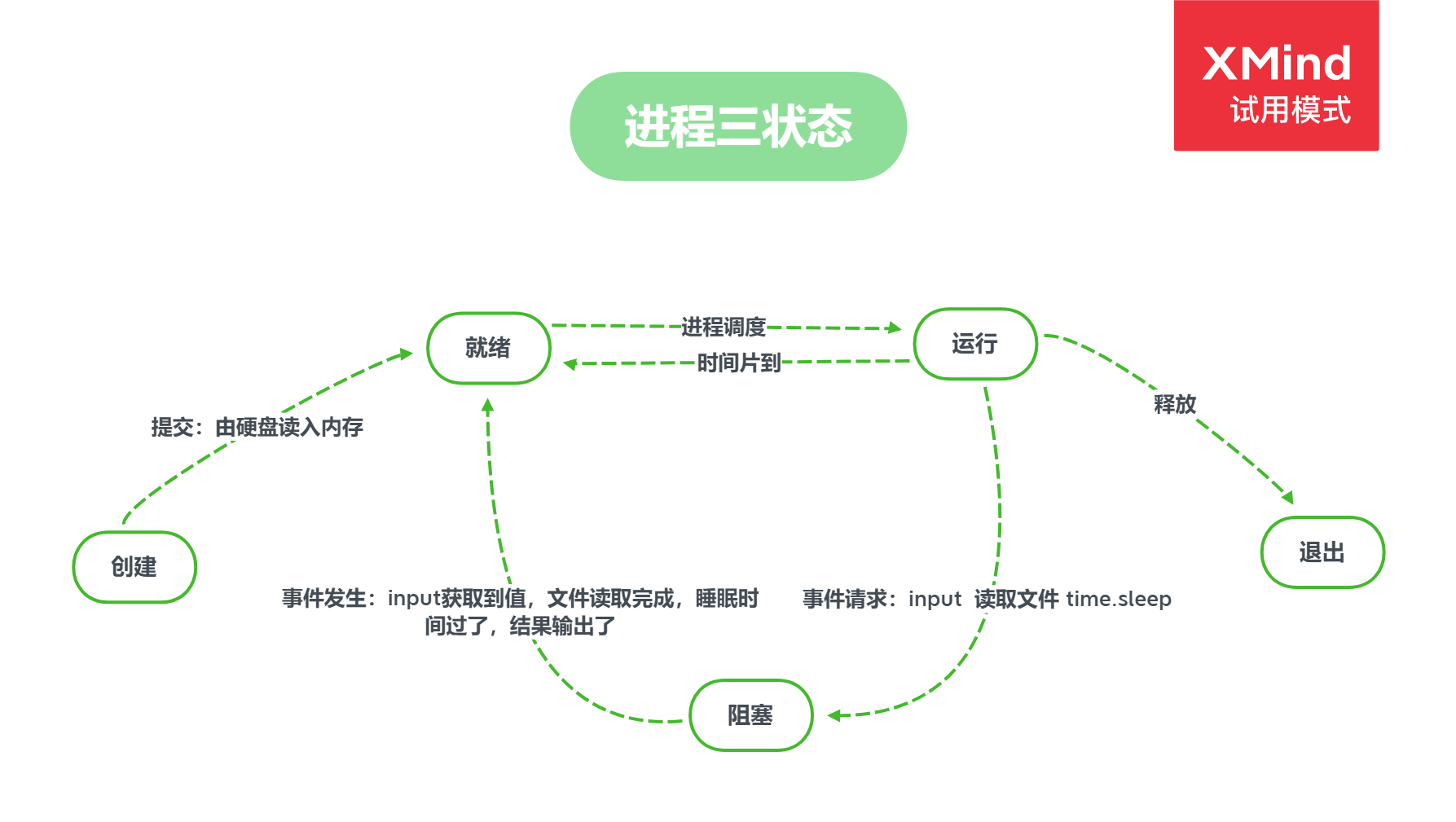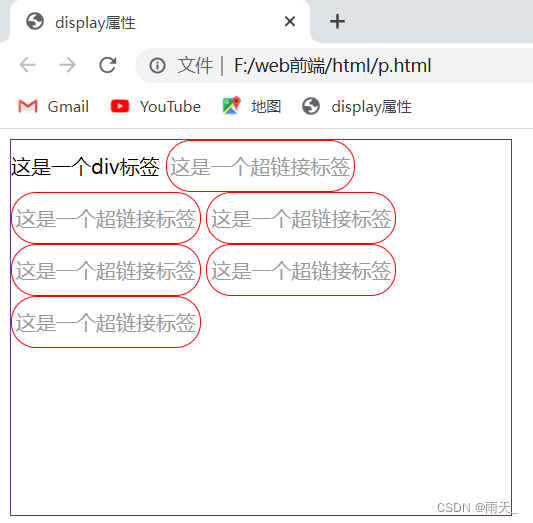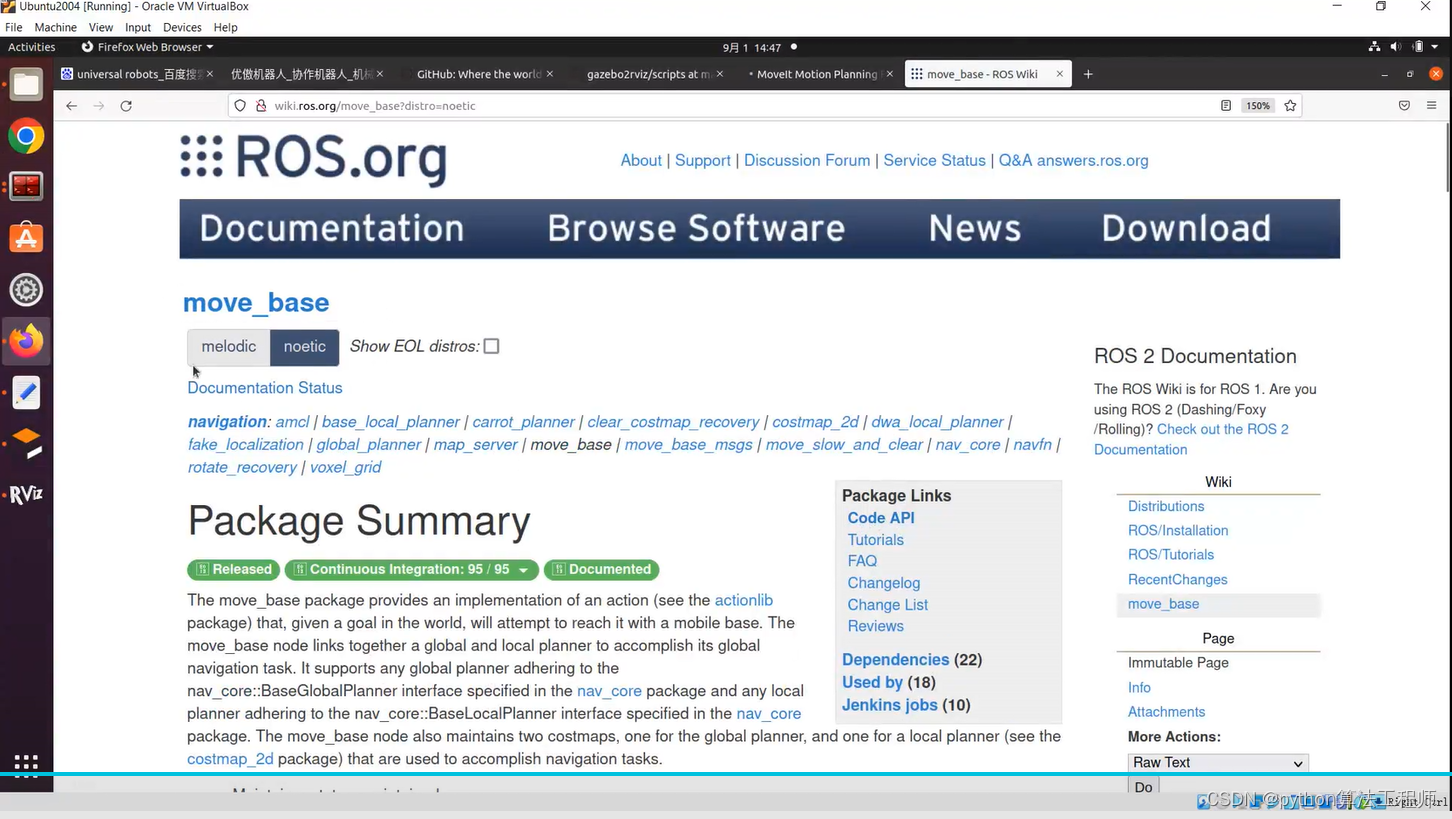在iOS中多线程开发有四种方式,在之前我们浅浅了解了一下GCD,这期来看看pthread和NSThread

pehread
pthread简介
pthread 是一套通用的多线程的 API,可以在Unix / Linux / Windows 等系统跨平台使用,使用 C 语言编写,需要程序员自己管理线程的生命周期,使用难度较大。
POSIX 线程(英语:POSIX Threads,常被缩写 为 Pthreads)是 POSIX 的线程标准,定义了创建和操纵线程的一套 API。
实现 POSIX 线程标准的库常被称作 Pthreads,一般用于 Unix-like POSIX 系统,如 Linux、Solaris。但是 Microsoft Windows 上的实现也存在,例如直接使用 Windows API 实现的第三方库 pthreads-w32;而利用 Windows 的 SFU/SUA 子系统,则可以使用微软提供的一部分原生 POSIX API。(维基百科)
pthread使用方法
1.首先要包含头文件#import <pthread.h>
2.其次要创建线程,并开启线程执行任务
//
// main.m
// pthread
//
// Created by 王璐 on 2023/5/6.
//#import <Foundation/Foundation.h>
#import <pthread.h>
void *run(void *param) {NSLog(@"1-> %@", [NSThread currentThread]);NSLog(@"2-> %@", [NSThread currentThread]);NSLog(@"3-> %@", [NSThread currentThread]);NSLog(@"4-> %@", [NSThread currentThread]);NSLog(@"5-> %@", [NSThread currentThread]);NSLog(@"6-> %@", [NSThread currentThread]);NSLog(@"7-> %@", [NSThread currentThread]);return NULL;
}
int main(int argc, const char * argv[]) {@autoreleasepool {// insert code here...pthread_t myThread;int res = pthread_create(&myThread, NULL, run, NULL);if (res == 0) {NSLog(@"创建成功");}pthread_detach(myThread);NSLog(@"%@", [NSThread currentThread]);}return 0;
}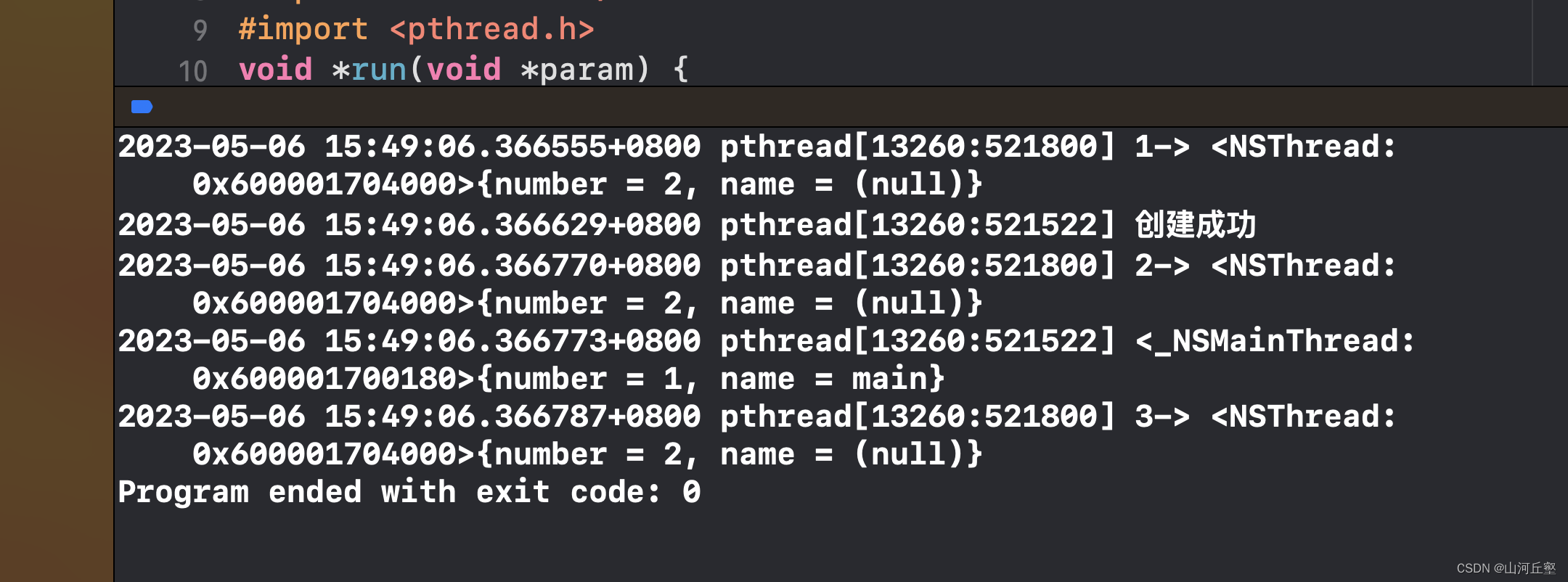

每次运行时结果不一样,这个问题还没能解决。
pthread_create(&thread, NULL, run, NULL); 中各项参数含义:
第一个参数&thread是线程对象,指向线程标识符的指针
第二个是线程属性,可赋值NULL
第三个run表示指向函数的指针(run对应函数里是需要在新线程中执行的任务)
第四个是运行函数的参数,可赋值NULL
pthread其他方法
- pthread_create() 创建一个线程
- pthread_exit() 终止当前线程
- pthread_cancel() 中断另外一个线程的运行
- pthread_join() 阻塞当前的线程,直到另外一个线程运行结束
- pthread_attr_init() 初始化线程的属性
- pthread_attr_setdetachstate() 设置脱离状态的属性(决定这个线程在终止时是否可以被结合)
- pthread_attr_getdetachstate() 获取脱离状态的属性
- pthread_attr_destroy() 删除线程的属性
- pthread_kill() 向线程发送一个信号
NSThread
NSThread 是苹果官方提供的,使用起来比 pthread 更加面向对象,简单易用,可以直接操作线程对象。不过也需要需要程序员自己管理线程的生命周期(主要是创建),我们在开发的过程中偶尔使用 NSThread。比如我们会经常调用[NSThread currentThread]来显示当前的进程信息
创建,启动线程
- 先创建线程,在启动线程
// 1. 创建线程
NSThread *thread = [[NSThread alloc] initWithTarget:self selector:@selector(run) object:nil];
// 2. 启动线程
[thread start]; // 线程一启动,就会在线程thread中执行self的run方法// 新线程调用方法,里边为需要执行的任务
- (void)run {NSLog(@"%@", [NSThread currentThread]);
}
- 创建线程后自动启动线程
// 1. 创建线程后自动启动线程
[NSThread detachNewThreadSelector:@selector(run) toTarget:self withObject:nil];// 新线程调用方法,里边为需要执行的任务
- (void)run {NSLog(@"%@", [NSThread currentThread]);
}
- 隐式创建并启动线程
// 1. 隐式创建并启动线程
[self performSelectorInBackground:@selector(run) withObject:nil];// 新线程调用方法,里边为需要执行的任务
- (void)run {NSLog(@"%@", [NSThread currentThread]);
}
// 获得主线程
+ (NSThread *)mainThread; // 判断是否为主线程(对象方法)
- (BOOL)isMainThread;// 判断是否为主线程(类方法)
+ (BOOL)isMainThread; // 获得当前线程
NSThread *current = [NSThread currentThread];// 线程的名字——setter方法
- (void)setName:(NSString *)n; // 线程的名字——getter方法
- (NSString *)name; - 线程状态控制方法
-
- 启动线程方法
- (void)start;
// 线程进入就绪状态 -> 运行状态。当线程任务执行完毕,自动进入死亡状态
-
- 阻塞(暂停)线程方法
+ (void)sleepUntilDate:(NSDate *)date;
+ (void)sleepForTimeInterval:(NSTimeInterval)ti;
// 线程进入阻塞状态-
- 强制停止线程
+ (void)exit;
// 线程进入死亡状态
- 线程之间的通信
在开发中,我们经常会在子线程进行耗时操作,操作结束后再回到主线程去刷新 UI。这就涉及到了子线程和主线程之间的通信。我们先来了解一下官方关于 NSThread 的线程间通信的方法。
// 在主线程上执行操作
- (void)performSelectorOnMainThread:(SEL)aSelector withObject:(id)arg waitUntilDone:(BOOL)wait;
- (void)performSelectorOnMainThread:(SEL)aSelector withObject:(id)arg waitUntilDone:(BOOL)wait modes:(NSArray<NSString *> *)array;// equivalent to the first method with kCFRunLoopCommonModes// 在指定线程上执行操作
- (void)performSelector:(SEL)aSelector onThread:(NSThread *)thr withObject:(id)arg waitUntilDone:(BOOL)wait modes:(NSArray *)array NS_AVAILABLE(10_5, 2_0);
- (void)performSelector:(SEL)aSelector onThread:(NSThread *)thr withObject:(id)arg waitUntilDone:(BOOL)wait NS_AVAILABLE(10_5, 2_0);// 在当前线程上执行操作,调用 NSObject 的 performSelector:相关方法
- (id)performSelector:(SEL)aSelector;
- (id)performSelector:(SEL)aSelector withObject:(id)object;
- (id)performSelector:(SEL)aSelector withObject:(id)object1 withObject:(id)object2;
举例一个加载图片的demo:
/*** 创建一个线程下载图片*/
- (void)downloadImageOnSubThread {// 在创建的子线程中调用downloadImage下载图片[NSThread detachNewThreadSelector:@selector(downloadImage) toTarget:self withObject:nil];
}/*** 下载图片,下载完之后回到主线程进行 UI 刷新*/
- (void)downloadImage {NSLog(@"current thread -- %@", [NSThread currentThread]);// 1. 获取图片 imageUrlNSURL *imageUrl = [NSURL URLWithString:@"https://ysc-demo-1254961422.file.myqcloud.com/YSC-phread-NSThread-demo-icon.jpg"];// 2. 从 imageUrl 中读取数据(下载图片) -- 耗时操作NSData *imageData = [NSData dataWithContentsOfURL:imageUrl];// 通过二进制 data 创建 imageUIImage *image = [UIImage imageWithData:imageData];// 3. 回到主线程进行图片赋值和界面刷新[self performSelectorOnMainThread:@selector(refreshOnMainThread:) withObject:image waitUntilDone:YES];
}/*** 回到主线程进行图片赋值和界面刷新*/
- (void)refreshOnMainThread:(UIImage *)image {NSLog(@"current thread -- %@", [NSThread currentThread]);UIButton* button = [UIButton buttonWithType:UIButtonTypeClose];button.frame = CGRectMake(100, 100, 100, 100);[button setImage:image forState:UIControlStateNormal];[self.view addSubview:button];
}

NSThread线程安全和线程同步
线程安全
如果你的代码所在的进程中有多个线程在同时运行,而这些线程可能会同时运行这段代码。如果每次运行结果和单线程运行的结果是一样的,而且其他的变量的值也和预期的是一样的,就是线程安全的。
若每个线程中对全局变量、静态变量只有读操作,而无写操作,一般来说,这个全局变量是线程安全的;若有多个线程同时执行写操作(更改变量),一般都需要考虑线程同步,否则的话就可能影响线程安全。
线程同步
可理解为线程 A 和 线程 B 一块配合,A 执行到一定程度时要依靠线程 B 的某个结果,于是停下来,示意 B 运行;B 依言执行,再将结果给 A;A 再继续操作。
火车票售卖
@property (nonatomic, strong) UIImageView *imageView;
@property (nonatomic, assign) int ticketSurplusCount;
@property (nonatomic, strong) NSThread *ticketSaleWindow1;
@property (nonatomic, strong) NSThread *ticketSaleWindow2;/*** 初始化火车票数量、卖票窗口(非线程安全)、并开始卖票*/
- (void)initTicketStatusNotSave {// 1. 设置剩余火车票为 10self.ticketSurplusCount = 10;// 2. 设置北京火车票售卖窗口的线程self.ticketSaleWindow1 = [[NSThread alloc]initWithTarget:self selector:@selector(saleTicketNotSafe) object:nil];self.ticketSaleWindow1.name = @"北京火车票售票窗口";// 3. 设置上海火车票售卖窗口的线程self.ticketSaleWindow2 = [[NSThread alloc]initWithTarget:self selector:@selector(saleTicketNotSafe) object:nil];self.ticketSaleWindow2.name = @"上海火车票售票窗口";// 4. 开始售卖火车票[self.ticketSaleWindow1 start];[self.ticketSaleWindow2 start];}/*** 售卖火车票(非线程安全)*/
- (void)saleTicketNotSafe {while (1) {//如果还有票,继续售卖if (self.ticketSurplusCount > 0) {self.ticketSurplusCount --;NSLog(@"%@", [NSString stringWithFormat:@"剩余票数:%d 窗口:%@", self.ticketSurplusCount, [NSThread currentThread].name]);[NSThread sleepForTimeInterval:0.2];}//如果已卖完,关闭售票窗口else {NSLog(@"所有火车票均已售完");break;}}
}两个线程相互竞争,得到票数是错乱的,这样显然不符合我们的需求,所以我们需要考虑线程安全问题。
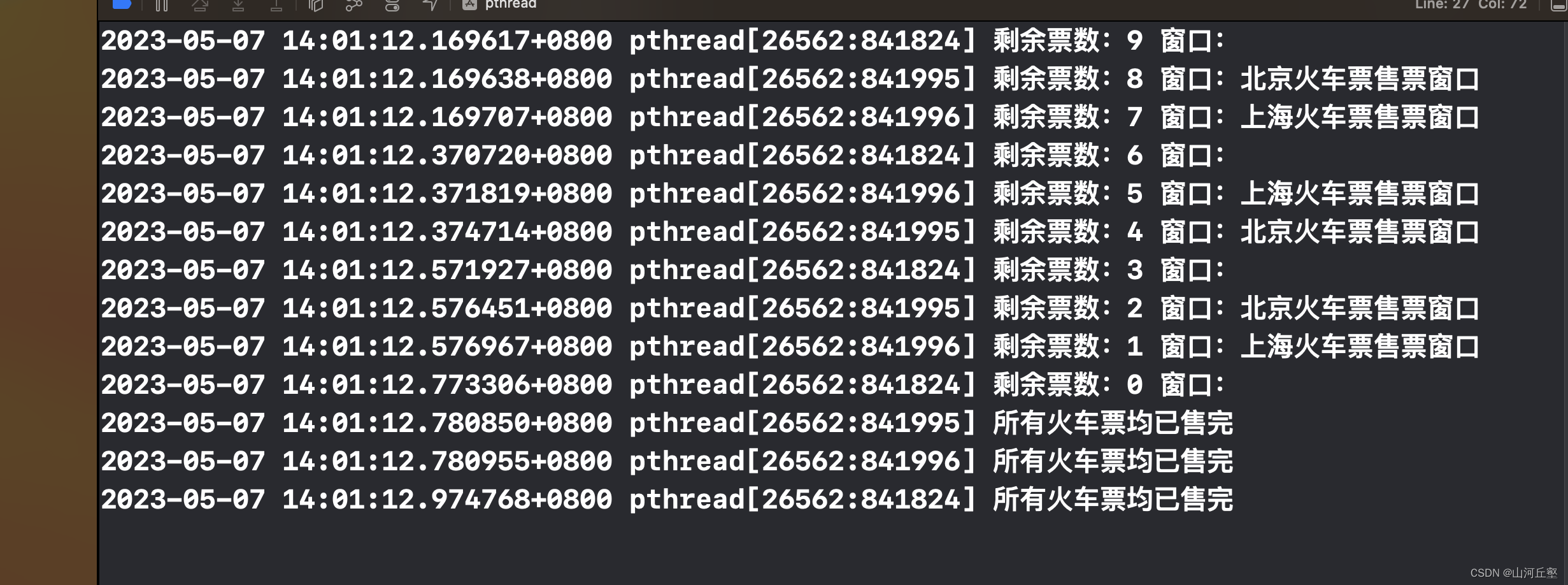
NSThread 线程安全
线程安全解决方案:可以给线程加锁,在一个线程执行该操作的时候,不允许其他线程进行操作。iOS 实现线程加锁有很多种方式。@synchronized、 NSLock、NSRecursiveLock、NSCondition、NSConditionLock、pthread_mutex、dispatch_semaphore、OSSpinLock、atomic(property) set/ge等等各种方式。为了简单起见,这里不对各种锁的解决方案和性能做分析,只用最简单的@synchronized来保证线程安全,从而解决线程同步问题。
/*** 初始化火车票数量、卖票窗口(线程安全)、并开始卖票*/
- (void)initTicketStatusSave {// 1. 设置剩余火车票为 10self.ticketSurplusCount = 10;// 2. 设置北京火车票售卖窗口的线程self.ticketSaleWindow1 = [[NSThread alloc]initWithTarget:self selector:@selector(saleTicketSafe) object:nil];self.ticketSaleWindow1.name = @"北京火车票售票窗口";// 3. 设置上海火车票售卖窗口的线程self.ticketSaleWindow2 = [[NSThread alloc]initWithTarget:self selector:@selector(saleTicketSafe) object:nil];self.ticketSaleWindow2.name = @"上海火车票售票窗口";// 4. 开始售卖火车票[self.ticketSaleWindow1 start];[self.ticketSaleWindow2 start];}/*** 售卖火车票(线程安全)*/
- (void)saleTicketSafe {while (1) {// 互斥锁@synchronized (self) {//如果还有票,继续售卖if (self.ticketSurplusCount > 0) {self.ticketSurplusCount --;NSLog(@"%@", [NSString stringWithFormat:@"剩余票数:%d 窗口:%@", self.ticketSurplusCount, [NSThread currentThread].name]);[NSThread sleepForTimeInterval:0.2];}//如果已卖完,关闭售票窗口else {NSLog(@"所有火车票均已售完");break;}}}
}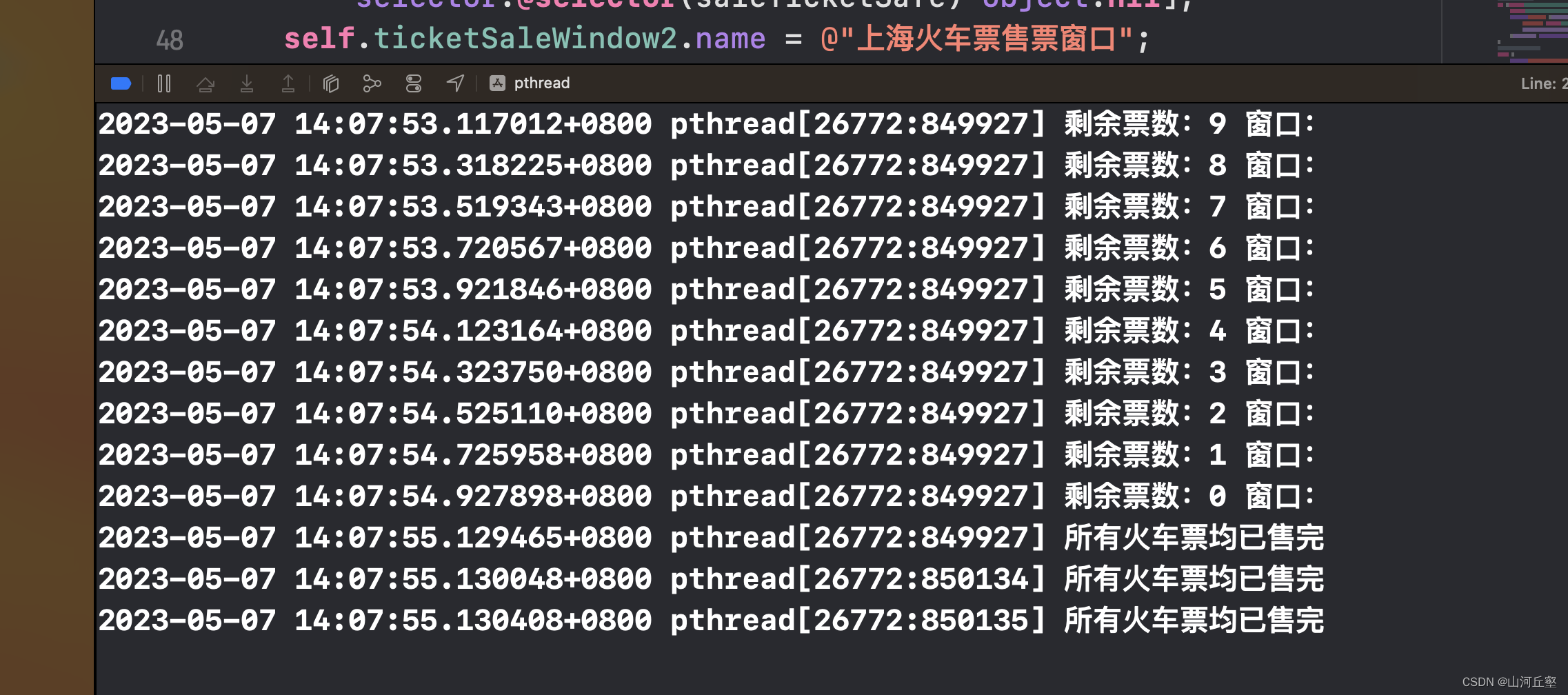
线程的状态转换
当我们新建一条线程NSThread *thread = [[NSThread alloc] initWithTarget:self selector:@selector(run) object:nil];,在内存中的表现为:

当调用[thread start];后,系统把线程对象放入可调度线程池中,线程对象进入就绪状态,如下图所示。
当然,可调度线程池中,会有其他的线程对象,如下图所示。在这里我们只关心左边的线程对象。
下边我们来看看当前线程的状态转换:
- 如果CPU现在调度当前线程对象,则当前线程对象进入运行状态,如果CPU调度其他线程对象,则当前线程对象回到就绪状态。
- 如果CPU在运行当前线程对象的时候调用了sleep方法\等待同步锁,则当前线程对象就进入了阻塞状态,等到sleep到时\得到同步锁,则回到就绪状态。
- 如果CPU在运行当前线程对象的时候线程任务执行完毕\异常强制退出,则当前线程对象进入死亡状态。

NSThread线程属性
name属性:设置线程的名字
NSThread *thread = [[NSThread alloc] initWithBlock:^{NSLog(@"线程:%@ start",[NSThread currentThread]);}];
thread.name = @"测试线程";
[thread start];qualityOfService属性:设置线程优先级
typedef NS_ENUM(NSInteger, NSQualityOfService) {NSQualityOfServiceUserInteractive = 0x21,NSQualityOfServiceUserInitiated = 0x19,NSQualityOfServiceUtility = 0x11,NSQualityOfServiceBackground = 0x09,NSQualityOfServiceDefault = -1
} API_AVAILABLE(macos(10.10), ios(8.0), watchos(2.0), tvos(9.0));
NSQualityOfServiceUserInteractive 优先级最高,从上到下依次降低,NSQualityOfServiceDefault 为默认优先级。
测试:
//qualityOfService属性:设置线程优先级
- (void)qualityOfServiceStudy {NSThread *thread1 = [[NSThread alloc] initWithBlock:^{NSLog(@"\n 线程:%@ start",[NSThread currentThread]);}];thread1.name = @"测试线程 1 ";[thread1 start];NSThread *thread2 = [[NSThread alloc] initWithBlock:^{NSLog(@"\n 线程:%@ start",[NSThread currentThread]);}];thread2.qualityOfService = NSQualityOfServiceUserInteractive;thread2.name = @"测试线程 2 ";[thread2 start];
}虽然 thread1 先于 thread2 start,但thread1优先级为默认,而thread2优先级为NSQualityOfServiceUserInteractive,在执行时,thread2 先于 thread1执行。
其他属性
-
- @property (class, readonly, copy) NSArray<NSNumber *> *callStackReturnAddresses //线程的调用会有函数的调用,该属性返回的就是 该线程中函数调用的虚拟地址数组。
-
- @property (class, readonly, copy) NSArray<NSString *> *callStackSymbols //该属性以符号的形式返回该线程调用函数。
//callStackReturnAddress和callStackSymbols这两个函数可以同NSLog联合使用来跟踪线程的函数调用情况,是编程调试的重要手段。
- @property (class, readonly, copy) NSArray<NSString *> *callStackSymbols //该属性以符号的形式返回该线程调用函数。
-
- @property (readonly, retain) NSMutableDictionary *threadDictionary; //每个线程有自己的堆栈空间,线程内维护了一个键-值的字典,它可以在线程里面的任何地方被访问。
//你可以使用该字典来保存一些信息,这些信息在整个线程的执行过程中都保持不变。
//比如,你可以使用它来存储在你的整个线程过程中 Run loop 里面多次迭代的状态信息。
- @property (readonly, retain) NSMutableDictionary *threadDictionary; //每个线程有自己的堆栈空间,线程内维护了一个键-值的字典,它可以在线程里面的任何地方被访问。
-
- @property (class, readonly, strong) NSThread *mainThread; // 获取主线程
-
- @property (class, readonly, strong) NSThread *currentThread;// 获取当前线程
-
- @property NSUInteger stackSize; // 线程使用堆栈大小,默认512k
-
- @property (readonly) BOOL isMainThread; // 是否是主线程
-
- @property (class, readonly) BOOL isMainThread ; // reports whether current thread is main
-
- @property (readonly, getter=isExecuting) BOOL executing ; // 线程是否正在执行
-
- @property (readonly, getter=isFinished) BOOL finished ; // 线程是否执行完毕
-
- @property (readonly, getter=isCancelled) BOOL cancelled; // 线程是否取消
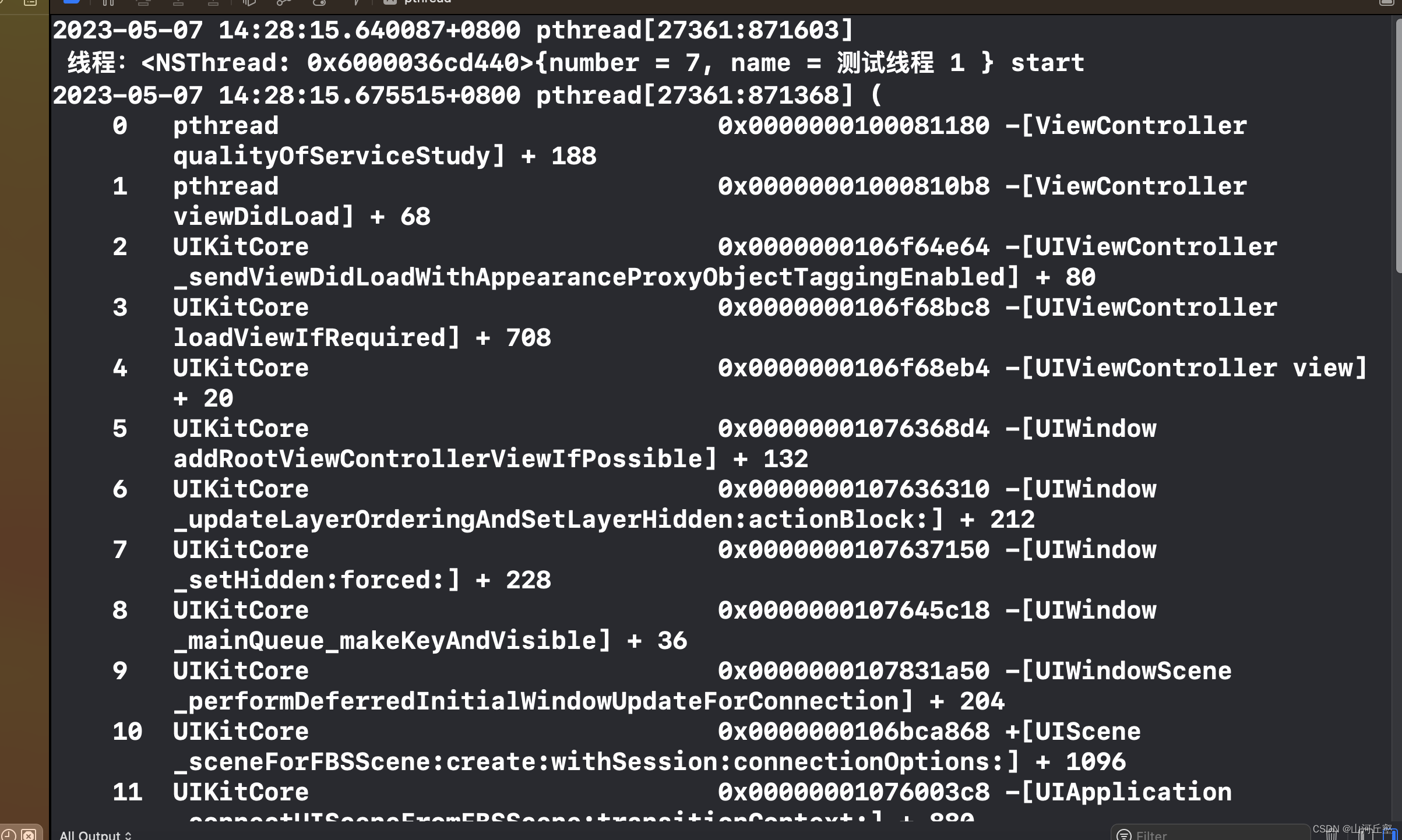


demo地址

